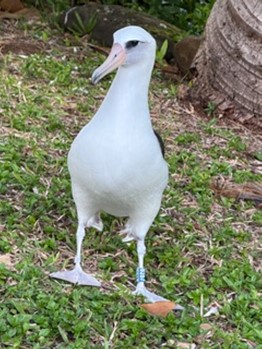
Laysan Albatross B267 on the Hawaiian island of Kauai, March 2025, photograph by Hob Osterlund
It is now well known that the low-lying atolls of the Northwestern Hawaiian Islands are at risk of losing their large populations of Near Threatened Laysan Albatrosses Phoebastria immutabilis from sea-level rise and storm surges thought due to climate change. In fact, some small islets that supported breeding albatrosses have already disappeared, such as Whale-Skate Islet in the 1990s and East Island in 2018, both in the French Frigate Shoals. As a consequence, efforts are being made to establish new colonies by translocating chicks to the high-level inhabited islands, notably on Oahu in the Kaena Point Natural Area Reserve and the James Campbell National Wildlife Refuge. On both Oahu and Kauai predator-proof fences have been constructed to give these new and existing colonies alike a better chance of successful breeding.
In addition, and complementary to these conservation efforts, some individual Laysan Albatrosses are translocating themselves without human intervention from low-lying to the higher-altitude islands towards the east. Here are accounts of just two of them.
Laysan Albatross B267 (white on blue colour band, metal band 1517-69467) was banded as a chick on Tern Island, French Frigate Shoals in June 2004. After fledging it was first seen again in the James Campbell NWR on Oahu in February 2022. It was next recorded (as a non-breeder) in March 2025 a couple of times on private land on the north shore of Kauai, where it was photographed and videoed next to a chick (not its own) by Hob Osterlund of the Kaua/i Albatross Network.
Hob writes about B267 to ACAP Latest News: “While it’s possible the bird has nested here and evaded observation, the likelihood is pretty low. We have spies all over the north shore, with greater diligence with each passing year. More likely he/she has nested elsewhere, especially since was previously spotted on O’ahu. The video was [made] on private land where I have seen the bird twice in two weeks. This is why the nesting colonies here [on Kauai] are vital: they have elevation, an absence of mongoose, and people who care--all the critical elements that make up a Noahʻs Ark”.
Another Tern Island Laysan Albatross (banded in June 2010 as KJ06 (black on yellow, metal band 2017-08906) has made the switch to higher ground. First encountered on Oahu in 2021 it has been documented over 10 times either on Oahu or on Kauai (mostly in the Kilauea Point National Wildlife Reserve). It was last encountered on Oahu on 12 December 204 and on Kauai on 19 March 2025.
Hopefully, both birds will settle down in colonies safe from sea level rise and commence to breed – time will tell!
With thanks to Hiob Osterlund, Kaua’i Albatross Network and Anna Vallery, USFWS.
John Cooper, Emeritus Information Officer, Agreement on the Conservation of Albatrosses and Petrels, 28 March 2025

 Español
Español  English
English  Français
Français